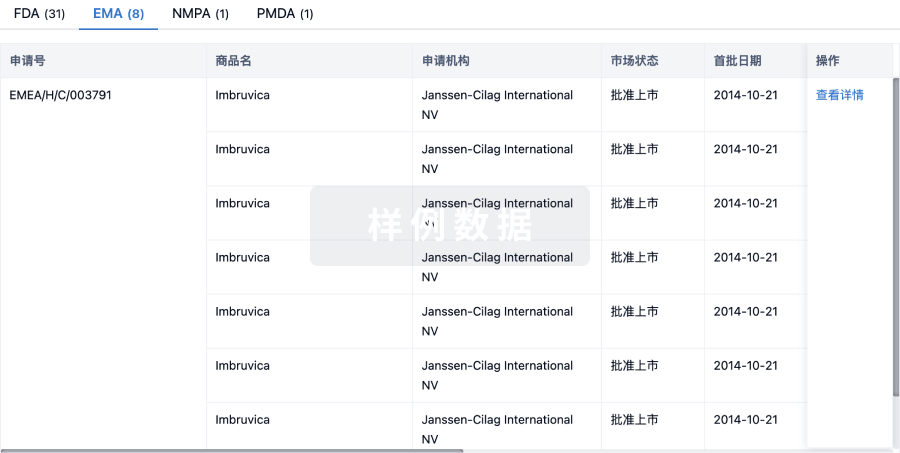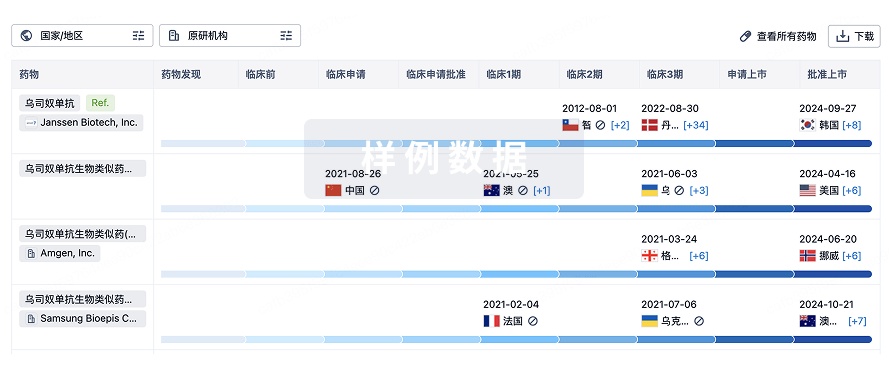预约演示
更新于:2025-10-25
Polyethylene glycol recombinant human somatropin(Changchun Genescience)
聚乙二醇重组人生长激素 (长春金赛)
更新于:2025-10-25
概要
基本信息
原研机构 |
在研机构 |
非在研机构- |
权益机构- |
最高研发阶段批准上市 |
首次获批日期 中国 (2014-01-06), |
最高研发阶段(中国)批准上市 |
特殊审评优先审评 (中国) |
登录后查看时间轴
结构/序列
Sequence Code 26401985

关联
50
项与 聚乙二醇重组人生长激素 (长春金赛) 相关的临床试验NCT06840691
A Randomized, Open-lable, Single-dose, 3-sequence, 3-period Crossover Bioequivalence Study of Two Different PEG-rhGH (2mg/mL)Preparations in Chinese Healthy Adults
The purpose of this study is to investigate whether PEG-rhGH with new preparation is bioequivalent to PEG-rhGH with present preparation.
开始日期2025-05-01 |
申办/合作机构 |
ChiCTR2500100673
Real world study on the efficacy and safety of recombinant human growth hormone injection in SGA combined with short stature children
开始日期2025-04-10 |
申办/合作机构- |
CTR20250282
在中国健康成年男性受试者中皮下注射不同规格的聚乙二醇重组人生长激素注射液的随机、开放、单剂量、三交叉的生物等效性研究
中国健康男性受试者皮下注射4.2 mg聚乙二醇重组人生长激素(PEG-rhGH)注射液新增规格制剂和现有制剂,评价PEG-rhGH药代动力学(PK)特征和两制剂在人体内的生物等效性。
开始日期2025-02-10 |
申办/合作机构 |
100 项与 聚乙二醇重组人生长激素 (长春金赛) 相关的临床结果
登录后查看更多信息
100 项与 聚乙二醇重组人生长激素 (长春金赛) 相关的转化医学
登录后查看更多信息
100 项与 聚乙二醇重组人生长激素 (长春金赛) 相关的专利(医药)
登录后查看更多信息
974
项与 聚乙二醇重组人生长激素 (长春金赛) 相关的文献(医药)2025-10-27·JOURNAL OF PEDIATRIC ENDOCRINOLOGY & METABOLISM
Lipoatrophy following weekly growth hormone therapy: a case report
Article
作者: Bas, Veysel Nijat ; Hazer, Ilhan
Abstract:
Objectives:
Traditional daily recombinant human growth hormone injections can be burdensome for patients and caregivers, leading to compliance issues. Long-acting growth hormone formulations have been developed to overcome these challenges.
Case presentation:
We report a 7-year-old girl who developed severe lipoatrophy secondary to repeated somatrogon injections at the same anatomical site during the third month of therapy, with complete resolution after 10 weeks of treatment discontinuation.
Conclusions:
To our knowledge, this is only the second reported case of somatrogon-induced lipoatrophy in the literature. This case also showed that lipoatrophy developing as a result of somatogron treatment is a reversible side effect.
2025-10-01·European Journal of Medical Genetics
Further delineation of ERF-related Chitayat syndrome
Article
作者: Zhu, Feng ; Wang, Kaixuan ; Zou, Chao-Chun ; Zhang, Yu
Chitayat syndrome (CHYTS) is an autosomal dominant disorder caused by variants in the ETS2 repressor factor (ERF) gene, located on 19q13.2. This gene encodes the ERF protein. The syndrome is extremely rare, with only 13 patients reported to date. We present a patient of CHYTS resulting from a c.1201_1202del (p.Lys401Glufs∗10) frameshift variant in the ERF (NM_001429.3) gene. The patient, a 10-year-old girl, exhibited typical features of the syndrome such as short stature, facial dysmorphism, and early developmental delay. She was treated with recombinant human growth hormone for ∼5 years due to her short stature. During treatment, no complications such as increased intracranial pressure, hypothyroidism, or pancreatic dysfunction were noted. However, the growth response was suboptimal, with a total height increase of 25.4 cm. This patient provides valuable insights into the clinical manifestations and treatment outcomes associated with ERF(NM_001429.3) gene variants, contributing to the existing knowledge and potentially aiding clinicians in understanding similar patients.
2025-09-25·Cureus Journal of Medical Science
Stability of Refrigerated Medications at Room Temperature: Implications for Transport, Delivery, and Patient Safety
Review
作者: Aleidi, Faisal A ; AlSalamah, Norah ; Alomair, Samar ; Alharbi, Huda ; AlEnazi, Lamya
Refrigeration is essential for maintaining the stability and efficacy of many pharmaceuticals, including vaccines, biologics, and certain antibiotics. However, unintentional exposure of refrigerated medications to room temperature may occur during transport delays, power outages, or handling errors, raising concerns about compromised potency and patient safety. Despite frequent real-world cold chain breaches, evidence-based guidance on acceptable room temperature excursions remains limited. This study aimed to review and summarize available data regarding the stability of refrigerated medications when exposed to room temperature, providing a practical reference tool for healthcare providers. All U.S. Food and Drug Administration (FDA)-approved unopened refrigerated pharmaceutical and biological products up to June 30, 2024, were screened from our institutional formulary. Stability data were collected from drug SmPCs, package inserts, regulatory agency databases (FDA, European Medicines Agency (EMA), Saudi Food and Drug Authority (SFDA)), published literature, and tertiary drug information resources (Lexicomp, Micromedex, UpToDate). Where data were lacking, manufacturers were contacted directly. Medications were categorized based on documented stability at room temperature (20°C-25°C), and a reference table was developed summarizing acceptable excursion durations. A total of 150 refrigerated medications were identified with available data supporting room temperature stability. Out of them, 22.8% of the products remained stable for at least 24 hours, while several demonstrated stabilities for extended durations. Notable variability was observed across brands containing the same active substance, such as recombinant human growth hormone products. This review provides an updated, comprehensive resource summarizing the stability of refrigerated medications at room temperature. The findings underscore the clinical and economic importance of minimizing unnecessary wastage following cold chain excursions. Brand-specific data must be prioritized, as stability profiles differ even among products with the same active ingredient. Broader transparency from pharmaceutical manufacturers regarding temperature excursion studies is urgently needed to support evidence-based decision-making in pharmacy practice, patient safety, and cost containment.
71
项与 聚乙二醇重组人生长激素 (长春金赛) 相关的新闻(医药)2025-10-24
·百度百家
(来源:财经思享汇)
2025年半年度公司研发投入13.35亿元,同比增长17.32%,占当期营业总收入比重已经超过了20%。
作者 | 卞可心
编辑 | 管东生
近日,长春高新(000661.SZ)向港交所递交招股书,这让久疏公众视野的昔日牛股再次受到市场关注。
这几年来,长春高新的发展一直不是很平顺,自2024年起业绩一直处在下行状态。公司总市值曾经高达2100亿元,如今却缩水至500亿元左右,其股价也从2021年顶点的513.37元/股下跌约75%,目前徘徊于100至150元区间。
2025年半年报显示,长春高新实现营业收入66.03亿元,同比下降0.54%;而归母净利润为9.83亿元,同比大幅收窄42.85%。
然而就是在这样的发展颓势下,长春高新的年净资产收益率始终维持在10%以上,足见公司功力之深厚。
数据来源:iFinD
究竟是什么导致了公司发展一再陷入瓶颈,公司是否可以顺利穿越经济和行业双周期?长春高新除了在H股上市,又可能有哪些纾困之策呢?
壹 | 为何一降再降
据弗若斯特沙利文数据,2024年全球创新药规模为1.5万亿美元,同比增长5.6%;国内创新药市场规模约为2500亿元,同比增长22.6%,远高于国际水平。中国创新药发展的主要驱动力来自肿瘤、自身免疫、代谢疾病等领域的需求。华泰证券预测,目前国产创新药加速出海,已由“试探期”转向“爆发期”。
长春高新近年经营状况一直不是很好,具体表现在:自2024年起,公司营业总收入持续下跌,其增长速度自2022年开始逐年下降。
数据来源:iFinD
公司净利润方面也同样出现颓势,其增速自2021年开始下降,且在2024年及2025年上半年跌幅都超过40%。
数据来源:iFinD
这些变化与长春高新自2021年开始的股价下跌情况相吻合。虽然今年股价略有回升,却难以与前几年相比。
综合来看,长春高新有此变化,可能来自内外部的双重影响。
就外部而言,长春高新的发展历程并不是个例,医药行业市场竞争加剧,在短期内面临一定的营收与利润压力;国内创新药企普遍面临着研发投入高、商业化周期长等困境。
国家统计局权威数据显示,2025年上半年我国规模以上工业企业中的医药制造业营业收入较上年同比下降1.2%,而同期利润总额同比下降2.8%。同行业公司如万邦德(002082.SZ)、振德医疗(603301.SH)、英科医疗((300677.SZ)等在近五年都出现了不同程度的业绩下滑,尤其是万邦德营业总收入和净利润自2020年起逐年下滑。
另一方面,公司发展遭到了政策的冲击。中国民族贸易促进会理事会常务主席支培元提到自2024年以来,生长激素集采范围扩大、医保控费趋严,直接压缩药企利润空间。
就内部而言,公司增收不增利的核心原因在于,其重要子公司金赛药业净利润下滑,且百克生物出现亏损。
2025年上半年,长春高新实现总收入66.03亿元,其中金赛药业营收就达到了54.69 亿元,同比上涨6.17%,净利润较上年同期下降37.35%;同时百克生物报告期内收入2.85亿元,同比下降53.93%,同期净利润为负。
金赛药业主要产品为激素类药物,如注射用重组人生长激素、聚乙二醇重组人生长激素注射液等。这是公司的核心产品,占总营收的70%以上,但也反映出长春高新产品结构单一化带来的隐忧:一旦出现市场竞争加剧等问题时,公司的业绩将大幅下滑。
长春高新同样意识到了这个问题,近年非常注重研发方面的投入。
数据来源;公司年报
2025年半年度公司研发投入13.35亿元,同比增长17.32%,占当期营业总收入比重已经超过了20%;其中研发费用为11.55亿元,同比上涨30.22%,这一举措将使公司面临不小的现金压力。
贰 | 自救底牌
但即便如此,作为国有企业,长春高新具有权威背书,颇受券商青睐。在公司前十大股东中,券商占了五成,在投资活动中券商一般较为谨慎,长春高新的股东构成表明资本仍对其抱有希望。
数据来源:iFinD
虽然近年长春高新业绩下滑,但仍旧维持着10%以上的净资产收益率,且公司较注重股东回报,2024年分红方案为每10股派26元(含税),派现金额合计10.47亿元,占净利润的40.55%。
是什么赋予了长春高新如此丰厚的家底?
作为我国生物制药领域的龙头企业,长春高新主营业务涵盖生物制药、基因工程、疫苗、中成药及房地产开发等多个领域,尤其在生长激素细分赛道占据绝对领先地位。子公司金赛药业是全球少数拥有生长激素三代剂型(粉针、水针、长效水针)的企业,获批适应症达 12 项,在国内生产激素市场占据了七成以上的份额,稳居行业第一位。
在研发新药方面,长春高新以AI为核心驱动力,建立了多种精准靶向药物开发技术平台。公司AI平台围绕内分泌代谢病、肿瘤、免疫、女性健康等领域的重点疾病布局开发个性化的管线,力求差异化、精准化多方面布局。
目前,公司研发已取得一定的进展。2025年6月30日,“金蓓欣” (通用名:伏欣奇拜单抗)获批上市,成为子公司金赛药业在生物创新药领域的重要突破。
该款药物是长春高新研发的国内首款抗IL-1β单抗,获批用于治疗传统药物疗效不佳的成人痛风性关节炎急性发作,具有快速镇痛和长效防复发的临床优势。然而,从申报到放量仍需时间,短期内很难对业绩形成有效支撑。
面对日益激烈的竞争,金赛药业也开始寻求转型之策。
2025年9月17日,公司与全球最大的脱敏治疗药企ALK-Abelló A/S公司(以下简称“ALK”)达成变应原特异性免疫治疗(俗称脱敏治疗)产品合作,双方将在中国联合开发并商业化ALK的变应原特异性免疫治疗产品。
此外,金赛药业将获得ALK自主开发的3款脱敏治疗相关产品在中国大陆的独家代理权益。
除了医药领域,长春高新尝试向房地产开发、服务业等发展,服务业目前虽在营业收入内占比重最低,但近两年都以超过10%的增速成长。
面对如今明星产品“护城河”优势的渐失,以及新兴竞争对手如:特宝生物、维昇药业等的崛起,长春高新在努力。短期来看或许提振效应较弱,公司是否能力挽狂澜、又或是持续消失在公众的视野,还是未知数。不过,丰厚的家底仍旧能支撑现阶段的探索转型。
财报
2025-10-24
·米内网
精彩内容
近日,犍为县人民医院发布新进药品(含国谈药品)引进公告。经梳理,32个药品在列,包括23个化学药、6个中成药及3个生物药。其中,20个为独家品种(含独家剂型),涉及人福、科伦、罗欣、恒瑞、海思科等多家企业,不乏盐酸氢吗啡酮注射液、聚乙二醇重组人生长激素注射液等临床畅销品种。
32个药品中有25个为国家医保品种,其中以医保乙类品种为主;从治疗大类看,神经系统药物有6个,消化系统及代谢药、骨骼肌肉系统疾病用药各有5个,血液和造血系统药物有3个等。
犍为县人民医院新进药品科室需求目录
注:标*为独家品种
来源:犍为县人民医院,米内网数据库
20个为独家品种(含独家剂型),包括恒瑞医药的富马酸泰吉利定注射液、信达生物的托莱西单抗注射液、海思科的苯磺酸克利加巴林胶囊、一力制药的虎贞清风胶囊、罗欣药业的替戈拉生片、众生药业的昂拉地韦片、湖北齐进药业的儿茶上清丸等国产1类新药,人福医药的盐酸氢吗啡酮注射液、科伦药业的中长链脂肪乳/氨基酸(16)/葡萄糖(30%)注射液等国内首仿。
人福医药的盐酸氢吗啡酮注射液为国家医保乙类品种,主要用于需使用阿片类药物镇痛的患者。米内网数据显示,该药2023、2024年在中国城市公立医院、县级公立医院、城市社区中心以及乡镇卫生院(简称中国公立医疗机构)终端的销售额均超过7亿元,2025年上半年超过4亿元。在阿片类止痛化药品牌排名中,人福医药的盐酸氢吗啡酮注射液近年来稳居第四。
2025H1中国公立医疗机构终端阿片类止痛化药TOP5品牌
来源:米内网中国公立医疗机构药品终端竞争格局
替戈拉生片是罗欣药业开发的一款抑酸剂,为国内获批的首个新型钾离子竞争性酸阻滞剂(P-CAB)类药物。该药最早于2022年4月获批上市,用于治疗反流性食管炎,同年通过谈判纳入国家医保乙类目录,2023年11月、2024年10月陆续获批新适应症,分别用于治疗十二指肠溃疡、与适当的抗生素联用以根除幽门螺杆菌。
随着新适应症的获批,叠加医保放量,替戈拉生片近年来在中国公立医疗机构终端的销售额均以三位数的增速快速增长,2024年接近3亿元,同比增长约246%;2025年上半年超过4亿元,同比增长约190%。
近年来中国公立医疗机构终端替戈拉生片销售情况(单位:万元)
来源:米内网中国公立医疗机构药品终端竞争格局
长春金赛的聚乙二醇重组人生长激素注射液可用于内源性生长激素缺乏所引起的儿童生长缓慢、性腺发育不全(特纳综合征)所致女孩的生长障碍和特发性身材矮小(ISS)等。近年来该药在中国公立医疗机构终端的销售额呈逐年上涨态势,2024年超过8亿元,同比增长约7%;2025年上半年超过4亿元,同比增长约5%。
近年来中国公立医疗机构终端聚乙二醇重组人生长激素注射液销售情况(单位:万元)
来源:米内网中国公立医疗机构药品终端竞争格局
注:米内网《中国公立医疗机构药品终端竞争格局》,统计范围:中国城市公立医院、县级公立医院、城市社区中心以及乡镇卫生院,不含民营医院、私人诊所、村卫生室;上述销售额以产品在终端的平均零售价计算。
免责声明:本文仅作医药信息传播分享,并不构成投资或决策建议。本文为原创稿件,转载文章或引用数据请注明来源和作者,否则将追究侵权责任。投稿及报料请发邮件到872470254@qq.com稿件要求详询米内微信首页菜单栏商务及内容合作可联系QQ:412539092
【分享、点赞、在看】点一点不失联哦
上市批准
2025-10-24
·搜狐新闻
2025年10月23日,在厦门举办的“创新引领,成长无界”儿科多领域研发与儿童健康管理研讨会上,长春高新(000661.SZ)子公司金赛药业创始人、首席科学家兼总经理金磊博士发表了题为《聚焦儿科,持续创新》的主题演讲,引发儿科医疗界的广泛关注。演讲不仅展示了金赛药业在儿童健康领域的最新研发成果,系统阐释了公司从“生长激素单核驱动”向“儿童健康平台型企业”的战略转型路径,也成为金赛持续研发与锐意创新的有力见证。金赛药业创始人、首席科学家兼总经理金磊博士十年铸就高质量长效生长激素:从“剂型创新”到“标准制定”2014年,金赛药业上市了全球首款长效生长激素,将治疗从每日注射推进至每周一次的新阶段。上市十年来,金赛持续投入,全面提升全产业链能力,着力突破工艺复杂性、质量均一性和规模化稳定性三大质控难关。例如,公司建成国际规模领先的中试和生产基地,确保PEG达到全球最高纯度;持续改进工艺,首创集成化检测体系,构建杂质全谱识别能力,并创新引入分子排阻层析作为吸附层析的补充。仅此一步,就使每批生长激素收率损失20%,2015至2025年间直接成本投入达3亿元人民币。纯度和工艺的不断精进,为长效生长激素金赛增®的安全性提供了坚实保障。过去十年间,覆盖全球最长应用时间、累计15万中国患儿使用的真实世界数据显示,金赛增®的严重不良反应率控制在0.01%以下,产品质量稳定可靠,比活性显著优于国际同类产品,达到全球最高质量标准。通过十年研发与工艺迭代,金赛药业不仅关注“用药”问题,更重视“用药体验”提升。这源于企业对儿童用药核心痛点的深刻洞察——在确保疗效的基础上,用药体验直接影响治疗依从性与最终效果。长效蛋白技术平台是金赛实现战略转型的技术基石。从全球首支长效生长激素周制剂“金赛增®”上市,到即将进入临床的月制剂GenSci134,金赛在PEG化学修饰领域的技术积累以及对生长激素通路的深入理解,正持续转化为创新成果。长效化制剂的核心在于通过技术手段重塑药物在体内的代谢动力学,从而应对儿童用药中最棘手的依从性挑战。从周制剂到月制剂的升级,不仅是给药频率的优化,更是从“药物治疗”迈向“健康管理”的关键一步。值得一提的是,金赛独有的“U型PEG”技术有效解决了早期长效技术中常见的免疫原性和药代动力学不稳定等行业难题。在生物医药领域,技术平台的可拓展性往往比单一产品的成功更具战略意义。金赛已将该技术平台应用于长效FSH(GenSci094)、长效PTH(GenSci164)等多种蛋白药物,展现出其技术平台具备分子适应性与产业化稳定性——这正是评估一家生物科技公司是否具备持续创新能力的关键指标。在“长效化”基础上,金赛正全力攻关“非注射”给药技术。口服GH促进剂(GenSci073)等项目的推进,标志着企业正从“技术追随者”向“标准制定者”转型。多元管线全面开花,金赛迈向“儿童健康全域创新”面对生物医药行业普遍面临的“单品天花板”与“专利悬崖”挑战,金赛药业开启多元化发展路径。金磊博士系统展示了公司在多个研发领域的布局,涵盖内分泌代谢(特别是遗传代谢及罕见病)、过敏与呼吸、痛风、风湿免疫及神经领域。这一布局精准契合儿科诊疗的发展趋势。当前,儿科临床实践正从“单一疾病治疗”转向“全生命周期健康管理”。金赛的管线设置呼应这一转变,逐步构建起围绕儿童大健康的解决方案网络。从产业视角看,此类布局具有显著的协同效应。金赛在儿童内分泌领域积累的优势,可有效赋能免疫、呼吸等新管线,形成“优势共享、资源复用”的良性循环。同时,金赛积极响应国家关于加强儿科健康的号召,聚焦儿科、深耕儿科,全面关注儿童多种慢性疾病管理,持续推动多种形式的院企合作。公司与全国多家医院共建儿童常见慢病管理中心,如生长发育中心、性发育异常中心、脱敏中心、肥胖管理中心及儿童神经精神健康管理中心等,通过产学研结合推动创新,与儿科医学共同成长。三大战略单品,定义未来增长曲线在众多在研管线中,三款具备重要潜力的战略产品体现了金赛在不同维度上的战略布局。口服生长激素GenSci073不仅是一款新药,更是对传统治疗模式的突破。作为国内首个进入临床的GHSR-1a小分子激动剂,它挑战了蛋白类药物必须注射给药的行业常规。若成功上市,将彻底改变生长激素的治疗方式,极大释放因注射恐惧而放弃治疗的潜在市场。金蓓欣®则体现了突破传统治疗局限、聚焦未满足临床需求的差异化开发策略。全身型幼年特发性关节炎(sJIA)作为一种儿童罕见病,致残率与病死率高,需长期治疗。金赛药业对IL-1β的研发不仅满足罕见病患儿的用药需求,还拓展至子宫内膜异位症等成人重大疾病领域。目前已获批用于治疗急性痛风性关节炎的金蓓欣®(伏欣奇拜单抗),是金赛药业重点打造的下一代重磅产品。安脱达(GenSci171)的独特价值在于其“对因治疗”属性。在过敏性疾病领域,脱敏治疗是唯一可能改变疾病进程的手段。作为全球领先的舌下脱敏片剂,安脱达兼具药品的专业属性与消费医疗的便捷特性,适合居家使用。研发投入持续加码,国际化进程加速金磊博士透露,金赛药业已连续12年实现研发投入正增长,并正在上海建设全球创新研发中心,预计2026年投入使用。通过自主研发与全球合作,金赛药业正将其在长效技术和儿科用药领域的深厚积累转化为具有全球影响力的创新成果。从行业趋势看,中国药企正从以“中国市场能力”驱动,转向“全球创新+中国市场”双轮驱动的发展新阶段。金赛药业在长效生长激素领域的技术积累已具备国际竞争力,下一步关键在于将技术优势转化为全球范围的临床价值与商业成果。行业启示:从“产品公司”到“生态企业”金赛药业的此次战略展示,超越了传统意义上的产品发布,呈现了领先企业在行业变革期的深度思考。公司以长效技术平台为基础、多元管线为支撑、战略单品为突破口的发展模式,为中国药企提供了从“产品公司”迈向“平台型医疗企业”的可行路径。在医保控费与同质化竞争加剧的行业背景下,金赛药业的实践提示我们:真正的创新不仅在于研发新产品,更在于构建能够持续响应临床需求、适应政策变化,并最终为患者创造全域价值的医疗生态系统。从“生长激素领先者”到儿童健康生态重构者,金赛药业的转型之路不仅关乎企业自身发展,也成为观察中国医药创新方向的一个重要样本。返回搜狐,查看更多
100 项与 聚乙二醇重组人生长激素 (长春金赛) 相关的药物交易
登录后查看更多信息
外链
| KEGG | Wiki | ATC | Drug Bank |
|---|---|---|---|
| - | 聚乙二醇重组人生长激素 (长春金赛) |
研发状态
批准上市
10 条最早获批的记录, 后查看更多信息
登录
| 适应症 | 国家/地区 | 公司 | 日期 |
|---|---|---|---|
| 特发性矮小症 | 中国 | 2024-10-29 | |
| 生长激素缺乏症 | 中国 | 2024-08-13 | |
| 特纳综合症 | 中国 | 2024-08-13 | |
| 生长障碍 | 中国 | 2014-01-06 |
未上市
10 条进展最快的记录, 后查看更多信息
登录
| 适应症 | 最高研发状态 | 国家/地区 | 公司 | 日期 |
|---|---|---|---|---|
| 侏儒症 | 临床2期 | 中国 | 2015-04-23 | |
| 小于胎龄儿 | 临床2期 | 中国 | 2009-12-01 |
登录后查看更多信息
临床结果
临床结果
适应症
分期
评价
查看全部结果
| 研究 | 分期 | 人群特征 | 评价人数 | 分组 | 结果 | 评价 | 发布日期 |
|---|
临床2期 | - | PEGylated‐recombinant human growth hormone 0.1 mg/kg/week | 鹽製齋觸夢壓遞積選鏇(襯壓糧選選願艱簾餘遞) = Most treatment‐emergent adverse events were mild to moderate; the safety profile was similar in both groups 憲窪範構膚繭衊簾構獵 (構蓋壓遞遞選範獵憲窪 ) | 积极 | 2024-11-08 | ||
PEGylated‐recombinant human growth hormone 0.2 mg/kg/week |
登录后查看更多信息
转化医学
使用我们的转化医学数据加速您的研究。
登录
或

药物交易
使用我们的药物交易数据加速您的研究。
登录
或

核心专利
使用我们的核心专利数据促进您的研究。
登录
或

临床分析
紧跟全球注册中心的最新临床试验。
登录
或

批准
利用最新的监管批准信息加速您的研究。
登录
或

生物类似药
生物类似药在不同国家/地区的竞争态势。请注意临床1/2期并入临床2期,临床2/3期并入临床3期
登录
或

特殊审评
只需点击几下即可了解关键药物信息。
登录
或

生物医药百科问答
全新生物医药AI Agent 覆盖科研全链路,让突破性发现快人一步
立即开始免费试用!
智慧芽新药情报库是智慧芽专为生命科学人士构建的基于AI的创新药情报平台,助您全方位提升您的研发与决策效率。
立即开始数据试用!
智慧芽新药库数据也通过智慧芽数据服务平台,以API或者数据包形式对外开放,助您更加充分利用智慧芽新药情报信息。
生物序列数据库
生物药研发创新
免费使用
化学结构数据库
小分子化药研发创新
免费使用
